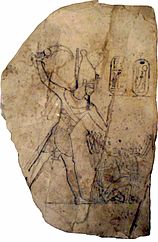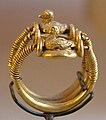|
Ramesses IV
Usermaatre Heqamaatre Setepenamun Ramesses IV (also written Ramses or Rameses) was the third pharaoh of the Twentieth Dynasty of the New Kingdom of Ancient Egypt. He was the second son of Ramesses III and became crown prince when his elder brother Amenherkhepshef died aged 15[4] in 1164 BC, when Ramesses was only 12 years old.[4][5] His promotion to crown prince:
As his father's chosen successor, the prince employed three distinctive titles: "Hereditary Prince", "Royal scribe" and "Generalissimo." The latter two titles are mentioned in a text at the temple of Amenhotep III at Soleb[6] and all three titles appear on a lintel now in Florence, Italy.[7] As heir-apparent he took on increasing responsibilities; for instance, in Year 27 of his father's reign, he is depicted appointing a certain Amenemope to the important position of Third Prophet of Amun in the latter's TT 148 tomb.[8] Amenemope's Theban tomb also accords prince Ramesses all three of his aforementioned sets of royal titles.[9] Despite the 31-year reign of his father Ramesses III, Ramesses IV was only 21 when he became pharaoh.[4] His rule has been dated to 1155 to 1149 BC. FamilyIt is now believed that Ramesses IV's mother was most likely Queen Tyti from recently discovered notes published in the 2010 issue of the Journal of Egyptian Archaeology.[10] They reveal that Tyti—who was a king's daughter, a king's wife and a king's mother in her own right—was identified in Papyrus BM EA 10052 (i.e., the tomb-robbery papyri) to be a queen of Ramesses III, Ramesses IV's father. The 2010 JEA article authors—including Aidan Dodson—write that since Ramesses VI's mother is known to be a certain lady named Iset Ta-Hemdjert or Isis:
Thus, the identity of Ramesses IV's mother has been resolved in favour of Queen Tyti who was once erroneously thought to be the mother of another king in the mid-1980s: Ramesses XI.[13] Ramesses IV was succeeded to the throne by his 13-year-old[14] son Ramesses V. Projects   Ramesses IV came to the throne in difficult circumstances. Ramesses III, his father, was assassinated by conspirators led by Tiye, one of his secondary wives, to establish Pentawer, her own son and Ramesses IV's half-brother, on the throne.[15] Ramesses IV, however, was able to secure himself on the throne, and had the conspirators arrested and executed. At the start of his reign, the pharaoh initiated a substantial building program on the scale of Ramesses II by doubling the size of the work gangs at Deir el-Medina to a total of 120 men and dispatching numerous expeditions to the stone quarries of Wadi Hammamat and the turquoise mines of the Sinai.[16] The Great Rock stela of Ramesses IV at Wadi Hammamat records that the largest expedition—dated to his Year 3, third month of Shemu day 27—consisted of 8,368 men alone including 5,000 soldiers, 2,000 personnel of the Amun temples, 800 Apiru and 130 stonemasons and quarrymen under the personal command of the High Priest of Amun, Ramessesnakht.[17] The scribes who composed the text also noted that this figure included 900 men "who are dead and omitted from this list."[4] Consequently, once this omitted figure is included to the tally of 8,368 men who served in the Year 3 quarry expedition, a total of 900 men out of an original expedition of 8,368 men perished during this endeavour for a mortality rate of 10.7%. Some of the stones which were dragged 60 miles to the Nile from Wadi Hammamat weighed 40 tons or more.[18] Other Egyptian quarries including Aswan were located much closer to the Nile which enabled them to use barges to transport stones long distances. Part of the king's program included the extensive enlargement of his father's Temple of Khonsu at Karnak and the construction of a large mortuary temple near the Temple of Hatshepsut. Ramesses IV also sent several expeditions to the turquoise mines in the Sinai; a total of four expeditions are known prior to his fourth year. The Serabit el-Khadim stela of the Royal Butler Sobekhotep states: "Year 3, third month of Shemu. His Majesty sent his favoured and beloved one, the confident of his lord, the Overseer of the Treasury of Silver and Gold, Chief of the Secrets of the august Palace, Sobekhotep, justified, to bring for him all that his heart desired of turquoise (on) his fourth expedition."[19] This expedition dates to either Ramesses III or IV's reign since Sobekhotep is attested in office until at least the reign of Ramesses V.[4] Ramesses IV's final venture to the turquoise mines of the Sinai is documented by the stela of a senior army scribe named Panufer. Panufer states that this expedition's mission was both to procure turquoise and to establish a cult chapel of king Ramesses IV at the Hathor temple of Serabit el-Khadim.[20] The stela reads:
While little is known regarding the route that the mining missions took from Egypt to Serabit el-Khadim, A. J. Peden, who wrote a biography of Ramesses IV in 1994, states that there were "two obvious routes" to reach this site:
Attestations Ramesses IV is attested by his aforementioned building activity at Wadi Hammamat and Serabit el-Khadim in the Sinai as well as several papyri and even one obelisk. The creation of a royal cult in the Temple of Hathor is known under his reign at Serabit el-Khadim while Papyrus Mallet (or P. Louvre 1050) dates to Years 3 and 4 of his reign.[4] Papyrus Mallet is a six column text dealing partly with agricultural affairs; its first column lists the prices for various commodities between Year 31 of Ramesses III until Year 3 of Ramesses IV.[4] The final four columns contain a memorandum of 2 letters composed by the Superintendent of Cattle of the Estate of Amen-Re, Bakenkhons, to several mid-level administrators and their subordinates.[4] Meanwhile, surviving monuments of Ramesses IV in the Delta consists of an obelisk recovered in Cairo and a pair of his cartouches found on a pylon gateway both originally from Heliopolis.[4] The most important document to survive from this pharaoh's rule is Papyrus Harris I, which honours the life of his father, Ramesses III, by listing the latter's many accomplishments and gifts to the temples of Egypt, and the Turin papyrus, the earliest known geologic map. Ramesses IV was perhaps the last New Kingdom king to engage in large-scale monumental building after his father as "there was a marked decline in temple building even during the longer reigns of Ramesses IX and VI. The only apparent exception was the attempt of Ramesses V and VI to continue the vast and uncompleted mortuary temple of Ramesses IV at the Assasif."[4] LevantAt Beirut, a 12th century burial shaft included a bone amulet with the cartouche of Ramesses IV.[22] Death Despite Ramesses IV's many endeavours for the gods and his prayer to Osiris—preserved on a Year 4 stela at Abydos—that "thou shalt give me the great age with a long reign [as my predecessor]", the king did not live long enough to accomplish his ambitious goals.[23] Ramesses IV's highest known date in the archaeological records is a Year 7, III Akhet day 23 ostracon[24] which, under the Egyptian dating system, meant that this ruler had a reign of just more than 6 full years. After a short reign of about six and a half years, Ramesses IV died and was buried in tomb KV2 in the Valley of the Kings. His mummy was found in the royal cache of Amenhotep II's tomb KV35 in 1898.[23] His chief wife is Queen Duatentopet or Tentopet or who was buried in QV74. His son, Ramesses V, would succeed him to the throne.[25] Originally, Ramesses IV had a tomb built for him in the Valley of the Queens, QV53. In April 2021 his mummy was moved from the Museum of Egyptian Antiquities to the National Museum of Egyptian Civilization along with those of 17 other kings and 4 queens in an event termed the Pharaohs' Golden Parade.[26] GalleryWikimedia Commons has media related to Ramses IV.
References
Further reading
|
||||||||||||||||||||||||||||||||||||||||||||||||||||||||||||||||||||||||||||||||||||||||||||||||||||||||||||||||||||||||||||||||||||||||||||||||||||||||||||||||||||||||||||||||||||





